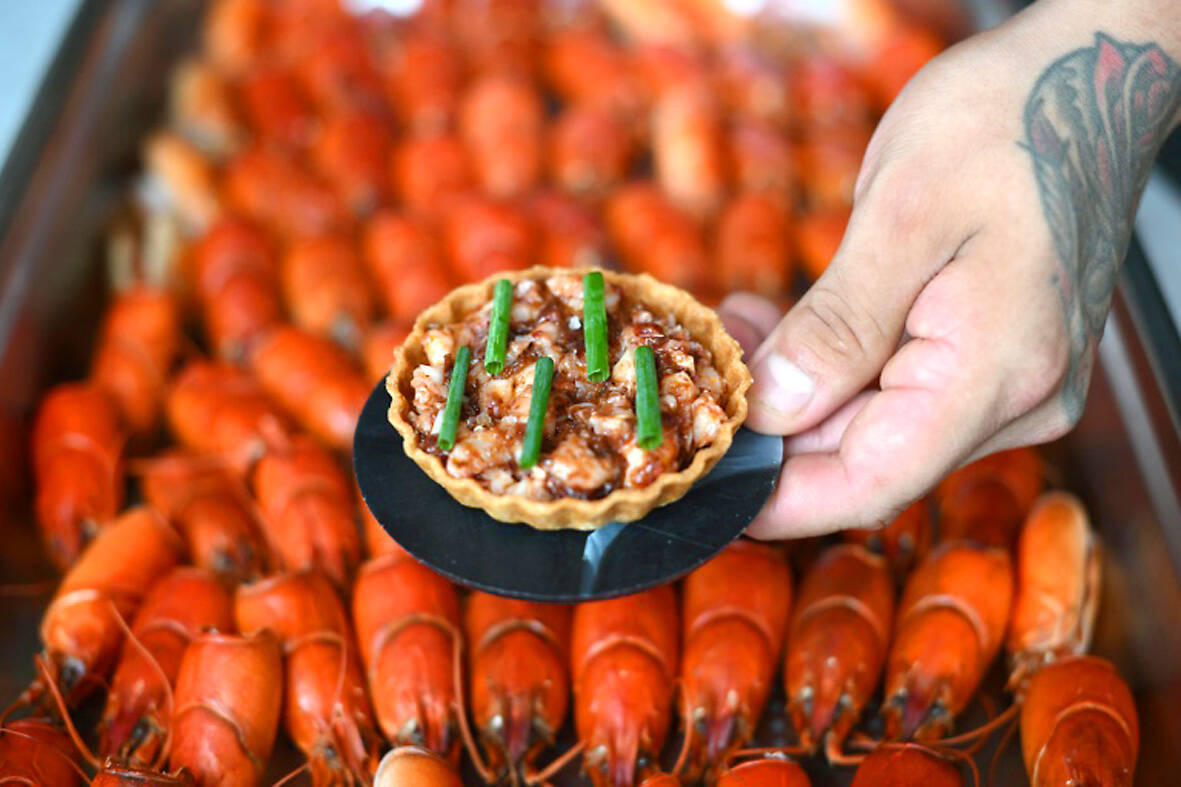A London restaurant is exploring whether eating invasive species such as grey squirrel, American Signal crayfish and Japanese knotweed could help fight their spread, but scientists remain skeptical. The idea behind several “invasive species supper clubs,” the last of which was served on Tuesday at “zero waste” Silo restaurant in east London, is to “creatively popularize species that are detrimental to the environment”, said chef Douglas McMaster, who runs the establishment.
The omnipresent grey squirrels, signal crayfish and Japanese knotweed are all “forces of destruction” that squeeze out local populations, but all are edible and “delicious,” he added.
The invaders are the subject of a recently published report under the aegis of the UN, which gave rise to calls from experts to “wake up” to the “scourge.”

Photo: AFP
McMaster would like a legitimate supply chain and for the species to become “an accessible resource” for chefs.
But the idea “isn’t to popularize these invasive species so there’s so much of a demand that we allow them to become more invasive,” he stressed. “That would be a terrible thing to occur.”
He hopes instead to “bring back balance within the ecosystem and then we stop eating them”.
‘OUT OF CONTROL’
But experts fear that the remedy will simply aggravate the problem.
“Consuming invasive non-native species isn’t something that I would encourage,” said Karim Vahed, professor of entomology at the University of Derby.
For Signal crayfish, which were imported in the 1970s for human consumption before escaping to colonize waterways — to the detriment of the native white-clawed crayfish — “there’s a potential that people will even introduce them themselves if they think that they can then be collected as food.”
The invasive specimens also transmit a fungal infection, “crayfish plague,” to which the American species are immune.
And their few predators — otters and herons — are too few to stem their spread.
“At the moment, the Signal is just spreading out of control,” warned Vahed.
The smaller, native crayfish, which have seen an 80-90 percent decline, are now at risk of extinction. In a small stream flowing through a park in Derby, central England, visitors can easily see the swarms of American crayfish. One of Vahed’s students found the first specimen there 16 years ago and within five years the invasive species had completely replaced the native one. Simply taking the largest ones does not help contain the spread. “You’re just helping the young American Signal crayfish to survive,” Vahed said. “So removing them and eating them isn’t a solution.”
‘VERY HUMAN RESPONSE’
The picture is more nuanced for Japanese knotweed, an invasive plant which can be eaten or used to brew beer.
“It could potentially be a good idea,” said knotweed specialist Karen Bacon, who found humor in the “very human response” of thinking “this plant is causing a problem, it is edible... let’s eat it!”
“But on the other hand, there are risks,” added the professor, who is based at the University of Galway, western Ireland. Disturbing the plant can actually enhance its growth, she said, adding that any project would need to be undertaken with experts “who understand the plant.”
“There is some potential in there, but it needs to be done carefully,” she said.

As Donald Trump’s executive order in March led to the shuttering of Voice of America (VOA) — the global broadcaster whose roots date back to the fight against Nazi propaganda — he quickly attracted support from figures not used to aligning themselves with any US administration. Trump had ordered the US Agency for Global Media, the federal agency that funds VOA and other groups promoting independent journalism overseas, to be “eliminated to the maximum extent consistent with applicable law.” The decision suddenly halted programming in 49 languages to more than 425 million people. In Moscow, Margarita Simonyan, the hardline editor-in-chief of the

Six weeks before I embarked on a research mission in Kyoto, I was sitting alone at a bar counter in Melbourne. Next to me, a woman was bragging loudly to a friend: She, too, was heading to Kyoto, I quickly discerned. Except her trip was in four months. And she’d just pulled an all-nighter booking restaurant reservations. As I snooped on the conversation, I broke out in a sweat, panicking because I’d yet to secure a single table. Then I remembered: Eating well in Japan is absolutely not something to lose sleep over. It’s true that the best-known institutions book up faster

The latest Formosa poll released at the end of last month shows confidence in President William Lai (賴清德) plunged 8.1 percent, while satisfaction with the Lai administration fared worse with a drop of 8.5 percent. Those lacking confidence in Lai jumped by 6 percent and dissatisfaction in his administration spiked up 6.7 percent. Confidence in Lai is still strong at 48.6 percent, compared to 43 percent lacking confidence — but this is his worst result overall since he took office. For the first time, dissatisfaction with his administration surpassed satisfaction, 47.3 to 47.1 percent. Though statistically a tie, for most

Though the total area of Penghu isn’t that large, exploring all of it — including its numerous outlying islands — could easily take a couple of weeks. The most remote township accessible by road from Magong City (馬公市) is Siyu (西嶼鄉), and this place alone deserves at least two days to fully appreciate. Whether it’s beaches, architecture, museums, snacks, sunrises or sunsets that attract you, Siyu has something for everyone. Though only 5km from Magong by sea, no ferry service currently exists and it must be reached by a long circuitous route around the main island of Penghu, with the